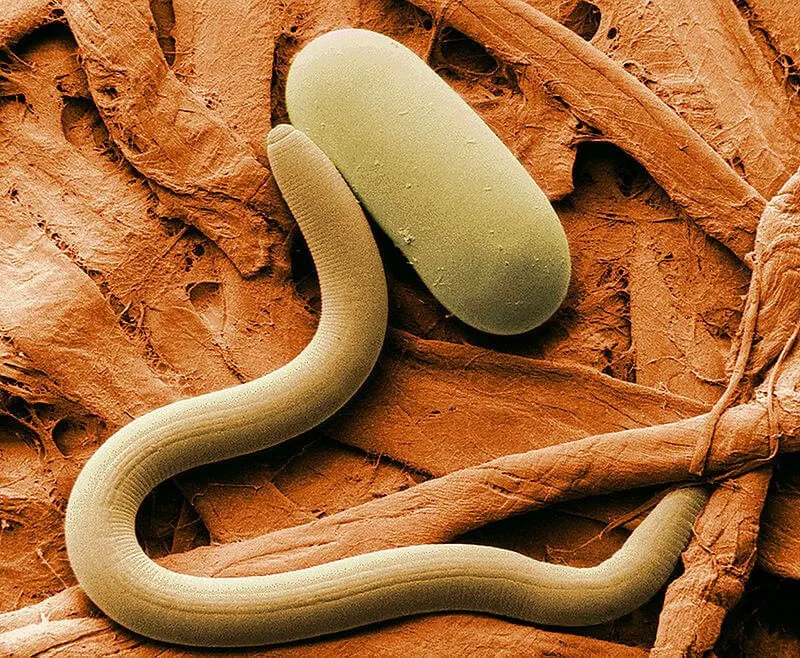Soil fungus could suppress soybean cyst nematodemore—cause of over $1 billion in yield losses every year
Soil fungus could suppress soybean cyst nematodemore—cause of over $1 billion in yield losses every year


The soybean cyst nematode sucks the nutrients out of soybean roots, causing more than $1 billion in soybean yield losses in the U.S. each year. A new study finds that one type of fungi can cut the nematodes’ reproductive success by more than half.
The researchers report their findings in the journal Plant Disease.
“Soybean cyst nematodes survive in the soil as eggs in cysts,” said Glen Hartman, a researcher for the U.S. Department of Agriculture’s Agricultural Research Service in the department of crop sciences at the University of Illinois at Urbana-Champaign. Hartman led the new research with graduate student Michelle Pawlowski. “The eggs hatch at the start of the growing season, and the juveniles penetrate root tissue and migrate into the plant’s vascular system. The females find a feeding site and stay there for the rest of their lives. They take nutrients away from the soybean plant, which reduces plant productivity.”
Previous studies have found that fungi in the soil that form mutually beneficial relationships with soybeans and other plants can influence the success of plant parasitic nematodes, including SCN. But the effectiveness of using these “arbuscular mycorrhizal fungi” to thwart plant parasitic fungi varies from study to study, making growers reluctant to embrace this as a method of control, Hartman said.
“In this study, we focused on five different species of arbuscular mycorrhizal fungi to see if they differed in their ability to protect soybeans against SCN,” Pawlowski said.
The researchers inoculated young soybean plants with fungi and SCN in greenhouse experiments. By the end of the experiment, all five fungal species had reduced the number of SCN cysts in the roots. The lowest number of cysts occurred on plants inoculated with the fungus Funneliformis mosseae. These averaged 10 cysts per plant. Soybean plants that were not inoculated with fungi accumulated 75 or more cysts per plant.
“Each cyst may contain hundreds of nematode eggs,” Hartman said.
Further experiments with F. mosseae revealed that exposure to the fungus reduced the number of juvenile nematodes on the plants by more than half.
“We found that as early as seven days after inoculation, roots that were inoculated with F. mosseae were colonized with significantly fewer nematode juveniles,” Pawlowski said.
“To see if this interaction and suppression might occur even earlier, we incubated SCN eggs in sterile water alone, with fungal spores or with exudates of the fungal spores. These exudates are microbes and molecules secreted by the spores,” she said.
This experiment revealed that the fungal spores and their exudates undermine nematode egg hatching, she said.
“If we can find out what function or compound from the fungi is suppressing egg hatching, that could potentially be a useful nematicide,” Pawlowski said.
Read the original post

 | Videos | More... |

Video: Nuclear energy will destroy us? Global warming is an existential threat? Chemicals are massacring bees? Donate to the Green Industrial Complex!
 | Bees & Pollinators | More... |

GLP podcast: Science journalism is a mess. Here’s how to fix it

Mosquito massacre: Can we safely tackle malaria with a CRISPR gene drive?

Are we facing an ‘Insect Apocalypse’ caused by ‘intensive, industrial’ farming and agricultural chemicals? The media say yes; Science says ‘no’
 | Infographics | More... |

Infographic: Global regulatory and health research agencies on whether glyphosate causes cancer
 | GMO FAQs | More... |

Why is there controversy over GMO foods but not GMO drugs?

How are GMOs labeled around the world?

How does genetic engineering differ from conventional breeding?
 | GLP Profiles | More... |

Alex Jones: Right-wing conspiracy theorist stokes fear of GMOs, pesticides to sell ‘health supplements’




 California, Washington, Oregon forge immunization alliance to safeguard vaccine access against federal undermining
California, Washington, Oregon forge immunization alliance to safeguard vaccine access against federal undermining Fighting deforestation with CO2: Biotechnology breakthrough creates sustainable palm oil alternative for cosmetics
Fighting deforestation with CO2: Biotechnology breakthrough creates sustainable palm oil alternative for cosmetics Trust issues: What happens when therapists use ChatGPT?
Trust issues: What happens when therapists use ChatGPT? 30-year-old tomato line shows genetic resistance to devastating virus
30-year-old tomato line shows genetic resistance to devastating virus Viewpoint — Fact checking MAHA mythmakers: How wellness influencers and RFK, Jr. undermine American science and health
Viewpoint — Fact checking MAHA mythmakers: How wellness influencers and RFK, Jr. undermine American science and health The free-range chicken dilemma: Better for birds, but with substantial costs
The free-range chicken dilemma: Better for birds, but with substantial costs Viewpoint: Video — Big Solar is gobbling up productive agricultural land and hurting farmers yet providing little energy or sustainabilty gains
Viewpoint: Video — Big Solar is gobbling up productive agricultural land and hurting farmers yet providing little energy or sustainabilty gains ‘You have to treat the brain first’:Rethinking chronic pain with Sanjay Gupta
‘You have to treat the brain first’:Rethinking chronic pain with Sanjay Gupta
